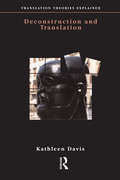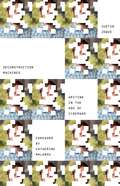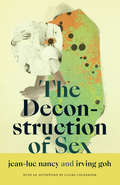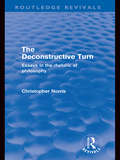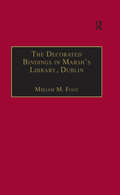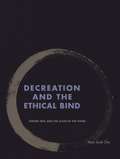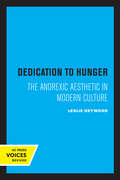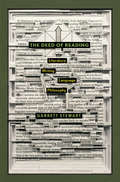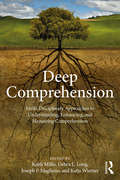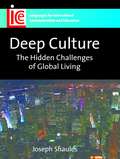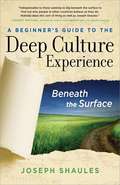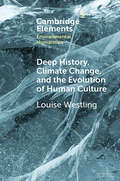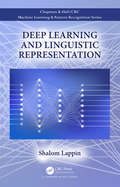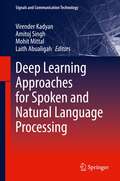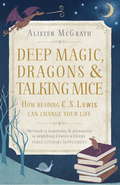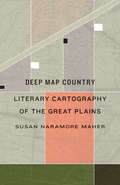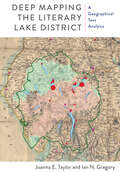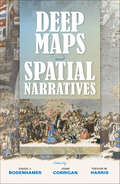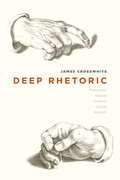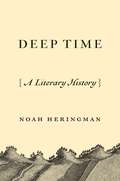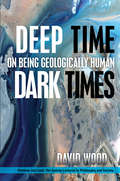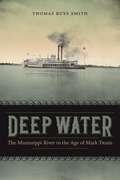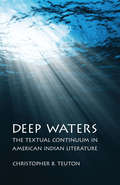- Table View
- List View
Deconstruction and Translation (Translation Theories Explored #Vol. 8)
by Kathleen DavisDeconstruction and Translation explains ways in which many practical and theoretical problems of translation can be rethought in the light of insights from the French philosopher Jacques Derrida. If there is no one origin, no transcendent meaning, and thus no stable source text, we can no longer talk of translation as meaning transfer or as passive reproduction. Kathleen Davis instead refers to the translator's freedom and individual responsibility. Her survey of this complex field begins from an analysis of the proper name as a model for the problem of signification and explains revised concepts of limits, singularity, generality, definitions of text, writing, iterability, meaning and intention. The implications for translation theory are then elaborated, complicating the desire for translatability and incorporating sharp critique of linguistic and communicative approaches to translation. The practical import of this approach is shown in analyses of the ways Derrida has been translated into English. In all, the text offers orientation and guidance through some of the most conceptually demanding and rewarding fields of contemporary translation theory.
Deconstruction Machines: Writing in the Age of Cyberwar (Electronic Mediations #54)
by Justin JoqueA bold new theory of cyberwar argues that militarized hacking is best understood as a form of deconstruction From shadowy attempts to steal state secrets to the explosive destruction of Iranian centrifuges, cyberwar has been a vital part of statecraft for nearly thirty years. But although computer-based warfare has been with us for decades, it has changed dramatically since its emergence in the 1990s, and the pace of change is accelerating.In Deconstruction Machines, Justin Joque inquires into the fundamental nature of cyberwar through a detailed investigation of what happens at the crisis points when cybersecurity systems break down and reveal their internal contradictions. He concludes that cyberwar is best envisioned as a series of networks whose constantly shifting connections shape its very possibilities. He ultimately envisions cyberwar as a form of writing, advancing the innovative thesis that cyber attacks should be seen as a militarized form of deconstruction in which computer programs are systems that operate within the broader world of texts. Throughout, Joque addresses hot-button subjects such as technological social control and cyber-resistance entities like Anonymous and Wikileaks while also providing a rich, detailed history of cyberwar. Deconstruction Machines provides a necessary new interpretation of deconstruction and timely analysis of media, war, and technology.
The Deconstruction of Sex (a Cultural Politics book)
by Jean-Luc Nancy Irving GohIn The Deconstruction of Sex, Jean-Luc Nancy and Irving Goh discuss how a deconstructive approach to sex helps us negotiate discourses about sex and foster a better understanding of how sex complicates our everyday existence in the age of #MeToo. Throughout their conversation, Nancy and Goh engage with topics ranging from relation, penetration, and subjection to touch, erotics, and jouissance. They show how despite its entrenchment in social norms and centrality to our being-in-the-world, sex lacks a clearly defined essence. At the same time, they point to the potentiality of literature to inscribe the senses of sex. In so doing, Nancy and Goh prompt us to reconsider our relations with ourselves and others through sex in more sensitive, respectful, and humble ways without bracketing the troubling aspects of sex.
The Deconstructive Turn: Essays in the Rhetoric of Philosophy (Routledge Revivals)
by Christopher NorrisWhat might be the outcome for philosophy if its texts were subjected to the powerful techniques of rhetorical close-reading developed by current deconstructionist literary critics? When first published in 1983, Christopher Norris’ book was the first to explore such questions in the context of modern analytic and linguistic philosophy, opening up a new and challenging dimension of inter-disciplinary study and creating a fresh and productive dialogue between philosophy and literary theory.
The Decorated Bindings in Marsh's Library, Dublin
by Mirjam M. FootAmong the many books in original bindings in Marsh's Library, Dublin, a surprisingly large number are in decorated blind- or gold-tooled, calf, pigskin or goatskin bindings, which date from the 15th to the 19th centuries. The bindings come from all over Europe, ranging from Ireland to eastern Europe. While most were made in England, some fine and interesting examples from Germany, Italy, France, Spain and Holland are also included. In this volume, leading scholar Mirjam Foot first gives an overview of how books were bound by hand and then describes the bindings by country of origin, within each section treating them chronologically and by type of decoration. The detailed descriptions of the bindings are illustrated with 52 black and white photos and 8 colour plates.
Decreation and the Ethical Bind: Simone Weil and the Claim of the Other
by Yoon Sook ChaIn Simone Weil’s philosophical and literary work, obligation emerges at the conjuncture of competing claims: the other’s self-affirmation and one’s own dislocation; what one has and what one has to give; a demand that asks for too much and the extraordinary demand implied by asking nothing. The other’s claims upon the self—which induce unfinished obligation, unmet sleep, hunger—drive the tensions that sustain the scene of ethical relationality at the heart of this book.Decreation and the Ethical Bind is a study in decreative ethics in which self-dispossession conditions responsiveness to a demand to preserve the other from harm. In examining themes of obligation, vulnerability, and the force of weak speech that run from Levinas to Butler, the book situates Weil within a continental tradition of literary theory in which writing and speech articulate ethical appeal and the vexations of response. It elaborates a form of ethics that is not grounded in subjective agency and narrative coherence but one that is inscribed at the site of the self’s depersonalization.
Dedication to Hunger: The Anorexic Aesthetic in Modern Culture
by Leslie HeywoodWriting as a competitive athlete, an academic, and a woman, Leslie Heywood merges personal history and scholarship to expose the "anorexic logic" that underlies Western high culture. She maneuvers deftly across the terrain of modern literature, illustrating how this logic—the privileging of mind over body, of hard over soft, of masculine over feminine—is at the heart of the modernist style. Her argument ranges from Plato to women's bodybuilding, from Franz Kafka to Nike ads. In penetrating examinations of Kafka, Pound, Eliot, William Carlos Williams, and Conrad, Heywood demonstrates how the anorexic aesthetic is embodied in high modernism. In a compelling chapter on Jean Rhys, Heywood portrays an author who struggles to develop a clean, spare, "anorexic" style in the midst of a shatteringly messy emotional life. As Heywood points out, students are trained in the aesthetic of high modernism, and academics are pressured into its straitjacket. The resulting complications are reflected in structures as diverse as gender identity formation, sexual harassment, and eating disorders. Direct, engaging, and intensely informed by the author's personal involvement with her subject, Dedication to Hunger offers a powerful challenge to cultural assumptions about language, gender, subjectivity, and identity. This title is part of UC Press's Voices Revived program, which commemorates University of California Press's mission to seek out and cultivate the brightest minds and give them voice, reach, and impact. Drawing on a backlist dating to 1893, Voices Revived makes high-quality, peer-reviewed scholarship accessible once again using print-on-demand technology. This title was originally published in 1996.
The Deed of Reading: Literature * Writing * Language * Philosophy
by Garrett StewartGarrett Stewart begins The Deed of Reading with a memory of his first hesitant confrontation, as a teenager, with poetic density. In that early verbal challenge he finds one driving force of literature: to make language young again in its surprise, coming alive in each new event of reading. But what exactly happens in the textual encounter to make literary phrasing resonate so deeply with readers?To take the measure of literary writing, The Deed of Reading convenes diverse philosophic commentary on the linguistics of literature, with stress on the complementary work of Stanley Cavell and Giorgio Agamben. Sympathetic to recent ventures in form-attentive analysis but resisting an emphasis on so-called surface reading, Stewart explores not some new formalism but the internal pressures of language in formation, registering the verbal infrastructure of literary prose as well as verse. In this mode of "contextual" reading, the context is language itself. Literary phrasing, tapping the speech act's own generative pulse, emerges as a latent philosophy of language in its own right, whereby human subjects, finding no secure place to situate themselves within language, settle for its taking place in, through, and between them.Stewart watches and hears this dynamics of wording played out in dozens of poems and novels over two centuries of English literary production--from Wordsworth and Shelley to Browning and Hopkins, from Poe and Dickens through George Eliot, Conrad, James, and on to Toni Morrison. The Deed of Reading offers a revisionary contribution to the ethic of verbal attention in the grip of "deep reading."
The Deep Blue Sea
by Roger C. Farr Dorothy S. StricklandThis book will take you to many place just by reading it. Come and sail on the deep blue sea. These stories will let you meet new faces. You can learn Indian water signs. You will read a Japanese folktale about two silly frogs. You will meet many different animals and people in this book.
Deep Comprehension: Multi-Disciplinary Approaches to Understanding, Enhancing, and Measuring Comprehension
by Keith K. Millis Debra Long Joseph Magliano Katja WiemerThis volume provides an overview of research from the learning sciences into understanding, enhancing, and measuring "deep comprehension" from a psychological, educational, and psychometric perspective. It describes the characteristics of deep comprehension, what techniques may be used to improve it, and how deep levels of comprehension may be distinguished from shallow ones. It includes research on personal-level variables; how intelligent tutors promote comprehension; and the latest developments in psychometrics. The volume will be of interest to senior undergraduate and graduate students of cognitive psychology, learning, cognition and instruction, and educational technology.
Deep Culture
by Joseph ShaulesA straightforward guide to understanding the hidden cultural challenges of adapting to life abroad. Combining intercultural theory and the voices of sojourners who talk about their experiences, it maps out the process of resisting, accepting and adapting to cultural difference. We see that all sojourners, from tourists, to expatriates to immigrants, go through a similar learning dynamic. We learn that intercultural experiences can be deep or shallow, and that hidden cultural difference can increase sojourner prejudice. The book examines intercultural sensitivity while avoiding "feel good" idealizations about cross-cultural contact. It brings clarity to debates regarding the importance of cultural difference and the effects of globalization. An essential resource for sojourners, language teachers and intercultural educators.
Deep Culture Experience: Beneath The Surface
by Joseph ShaulesShaules proposes the idea of a "deep culture journey,” in which travelers pursue not only the surface of travel, but the entire cross-cultural experience. Including an accessible introduction to traveling internationally for business or work while simultaneously enjoying the hidden culture beneath the surface, Shaules emphasizes that experiences abroad can teach us more about ourselves.
Deep History, Climate Change, and the Evolution of Human Culture (Elements in Environmental Humanities)
by Louise WestlingThis Element follows the development of humans in constantly changing climates and environments from Homo erectus 1.9 million years ago, to fully modern humans who moved out of Africa to Europe and Asia 70,000 years ago. Biosemiotics reveals meaningful communication among coevolving members of the intricately connected life forms on this dynamic planet. Within this web hominins developed culture from bipedalism and meat-eating to the use of fire, stone tools, and clothing, allowing wide migrations and adaptations. Archaeology and ancient DNA analysis show how fully modern humans overlapped with Neanderthals and Denisovans before emerging as the sole survivors of the genus Homo 35,000 years ago. Their visions of the world appear in magnificent cave paintings and bone sculptures of animals, then more recently in written narratives like the Gilgamesh epic and Euripides' Bacchae whose images still haunt us with anxieties about human efforts to control the natural world.
Deep Learning and Linguistic Representation (Chapman And Hall/crc Machine Learning And Pattern Recognition Ser.)
by Shalom LappinThe application of deep learning methods to problems in natural language processing has generated significant progress across a wide range of natural language processing tasks. For some of these applications, deep learning models now approach or surpass human performance. While the success of this approach has transformed the engineering methods of machine learning in artificial intelligence, the significance of these achievements for the modelling of human learning and representation remains unclear. Deep Learning and Linguistic Representation looks at the application of a variety of deep learning systems to several cognitively interesting NLP tasks. It also considers the extent to which this work illuminates our understanding of the way in which humans acquire and represent linguistic knowledge. Key Features: combines an introduction to deep learning in AI and NLP with current research on Deep Neural Networks in computational linguistics. is self-contained and suitable for teaching in computer science, AI, and cognitive science courses; it does not assume extensive technical training in these areas. provides a compact guide to work on state of the art systems that are producing a revolution across a range of difficult natural language tasks.
Deep Learning Approaches for Spoken and Natural Language Processing (Signals and Communication Technology)
by Virender Kadyan Amitoj Singh Mohit Mittal Laith AbualigahThis book provides insights into how deep learning techniques impact language and speech processing applications. The authors discuss the promise, limits and the new challenges in deep learning. The book covers the major differences between the various applications of deep learning and the classical machine learning techniques. The main objective of the book is to present a comprehensive survey of the major applications and research oriented articles based on deep learning techniques that are focused on natural language and speech signal processing. The book is relevant to academicians, research scholars, industrial experts, scientists and post graduate students working in the field of speech signal and natural language processing and would like to add deep learning to enhance capabilities of their work.Discusses current research challenges and future perspective about how deep learning techniques can be applied to improve NLP and speech processing applications;Presents and escalates the research trends and future direction of language and speech processing;Includes theoretical research, experimental results, and applications of deep learning.
Deep Magic, Dragons and Talking Mice: How Reading C.S. Lewis Can Change Your Life
by Dr Alister E McGrathWhat if you could ask C. S. Lewis his thoughts on the questions we all ask ourselves from time to time - questions about friendship, education, suffering, God ... and the meaning of life itself?Alister McGrath's provocative and perceptive book Deep Magic, Dragons and Talking Mice takes Lewis as the perfect conversation companion for the persistent meaning-of-life questions everyone asks. Lewis travelled from staunch atheism to reluctant belief, from rational scepticism to the appreciation of human desires and imagination, and from Christian apologist during the Second World War to celebrated author of classic children's literature - and as such looked at life's mysteries from many different viewpoints. The questions Lewis thought so deeply about are still relevant today, and all are illuminated by his astonishingly varied body of work. Whether you're new to Lewis, a fan of the Narnia books or a devotee of his apologetic writings, McGrath will lead you into an exploration of life's deepest questions, using one of the twentieth century's most engaging writers as our guide.
Deep Map Country: Literary Cartography of the Great Plains
by Susan Naramore MaherTaking its name from the subtitle of William Least Heat-Moon’s PrairyErth (a deep map), the “deep-map” form of nonfiction and environmental writing defines an innovative and stratigraphic literary genre. Proposing that its roots can be found in Great Plains nonfiction writing, Susan Naramore Maher explores the many facets of this vital form of critique, exploration, and celebration that weaves together such elements of narrative as natural history, cultural history, geography, memoir, and intertextuality. Maher’s Deep Map Country gives readers the first book-length study of the deep-map nonfiction of the Great Plains region, featuring writers as diverse as Julene Bair, Sharon Butala, Loren Eiseley, Don Gayton, Linda Hasselstrom, William Least Heat-Moon, John Janovy Jr., John McPhee, Kathleen Norris, and Wallace Stegner. Deep Map Country examines the many layers of storytelling woven into their essays: the deep time of geology and evolutionary biology; the cultural history of indigenous and settlement communities; the personal stories of encounters with this expansive terrain; the political and industrial stories that have affected the original biome and Plains economies; and the spiritual dimensions of the physical environment that press on everyday realities.
Deep Mapping the Literary Lake District: A Geographical Text Analysis (Aperçus: Histories Texts Cultures)
by Joanna E. Taylor Ian N. GregoryEngland’s famed Lake District—best known as the place of inspiration for the Wordsworths, Samuel Taylor Coleridge, and other Romantic-era writers—is the locus of this pioneering study, which implements and critiques a new approach to literary analysis in the digital age. Deploying innovative methods from literary studies, corpus linguistics, historical geography, and geographical information science, Deep Mapping the Literary Lake District combines close readings of a body of writing about the region from 1622-1900 with distant approaches to textual analysis. This path-breaking volume exemplifies interdisciplinarity, demonstrating how digital humanities methodologies and geospatial tools can enhance our appreciation of a region whose topography has been long recognized as fundamental to the shape of the poetry and prose produced within it.
Deep Maps and Spatial Narratives (The Spatial Humanities)
by David J. Bodenhamer John Corrigan Trevor M. HarrisDeep maps are finely detailed, multimedia depictions of a place and the people, buildings, objects, flora, and fauna that exist within it and which are inseparable from the activities of everyday life. These depictions may encompass the beliefs, desires, hopes, and fears of residents and help show what ties one place to another. A deep map is a way to engage evidence within its spatio-temporal context and to provide a platform for a spatially-embedded argument. The essays in this book investigate deep mapping and the spatial narratives that stem from it. The authors come from a variety of disciplines: history, religious studies, geography and geographic information science, and computer science. Each applies the concepts of space, time, and place to problems central to an understanding of society and culture, employing deep maps to reveal the confluence of actions and evidence and to trace paths of intellectual exploration by making use of a new creative space that is visual, structurally open, multi-media, and multi-layered.
Deep Rhetoric: Philosophy, Reason, Violence, Justice, Wisdom
by James Crosswhite"Rhetoric is the counterpart of logic," claimed Aristotle. "Rhetoric is the first part of logic rightly understood," Martin Heidegger concurred. "Rhetoric is the universal form of human communication," opined Hans-Georg Gadamer. But in Deep Rhetoric, James Crosswhite offers a groundbreaking new conception of rhetoric, one that builds a definitive case for an understanding of the discipline as a philosophical enterprise beyond basic argumentation and is fully conversant with the advances of the New Rhetoric of Chaïm Perelman and Lucie Olbrechts-Tyteca. Chapter by chapter, Deep Rhetoric develops an understanding of rhetoric not only in its philosophical dimension but also as a means of guiding and conducting conflicts, achieving justice, and understanding the human condition. Along the way, Crosswhite restores the traditional dignity and importance of the discipline and illuminates the twentieth-century resurgence of rhetoric among philosophers, as well as the role that rhetoric can play in future discussions of ontology, epistemology, and ethics. At a time when the fields of philosophy and rhetoric have diverged, Crosswhite returns them to their common moorings and shows us an invigorating new way forward.
Deep Rhetoric: Philosophy, Reason, Violence, Justice, Wisdom
by James Crosswhite“Rhetoric is the counterpart of logic,” claimed Aristotle. “Rhetoric is the first part of logic rightly understood,” Martin Heidegger concurred. “Rhetoric is the universal form of human communication,” opined Hans-Georg Gadamer. But in Deep Rhetoric, James Crosswhite offers a groundbreaking new conception of rhetoric, one that builds a definitive case for an understanding of the discipline as a philosophical enterprise beyond basic argumentation and is fully conversant with the advances of the New Rhetoric of Chaïm Perelman and Lucie Olbrechts-Tyteca. Chapter by chapter, Deep Rhetoric develops an understanding of rhetoric not only in its philosophical dimension but also as a means of guiding and conducting conflicts, achieving justice, and understanding the human condition. Along the way, Crosswhite restores the traditional dignity and importance of the discipline and illuminates the twentieth-century resurgence of rhetoric among philosophers, as well as the role that rhetoric can play in future discussions of ontology, epistemology, and ethics. At a time when the fields of philosophy and rhetoric have diverged, Crosswhite returns them to their common moorings and shows us an invigorating new way forward.
Deep Time: A Literary History
by Noah HeringmanHow the concept of “deep time” began as a metaphor used by philosophers, poets, and naturalists in the eighteenth and nineteenth centuriesIn this interdisciplinary book, Noah Heringman argues that the concept of “deep time”—most often associated with geological epochs—began as a metaphorical language used by philosophers, poets, and naturalists of the eighteenth and nineteenth centuries to explore the origins of life beyond the written record. Their ideas about “the abyss of time” created a way to think about the prehistoric before it was possible to assign dates to the fossil record. Heringman, examining stories about the deep past by visionary thinkers ranging from William Blake to Charles Darwin, challenges the conventional wisdom that the idea of deep time came forth fully formed from the modern science of geology. Instead, he argues, it has a rich imaginative history.Heringman considers Johann Reinhold Forster and Georg Forster, naturalists on James Cook’s second voyage around the world, who, inspired by encounters with Pacific islanders, connected the scale of geological time to human origins and cultural evolution; Georges-Louis Leclerc, Comte de Buffon, who drew on travel narrative, antiquarian works, and his own fieldwork to lay out the first modern geological timescale; Blake and Johann Gottfried Herder, who used the language of fossils and artifacts to promote ancient ballads and “prehistoric song”; and Darwin’s exploration of the reciprocal effects of geological and human time. Deep time, Heringman shows, has figural and imaginative dimensions beyond its geological meaning.
Deep Time, Dark Times: On Being Geologically Human (Thinking Out Loud)
by David WoodThe new geological epoch we call the Anthropocene is not just a scientific classification. It marks a radical transformation in the background conditions of life on Earth, one taken for granted by much of who we are and what we hope for. Never before has a species possessed both a geological-scale grasp of the history of the Earth and a sober understanding of its own likely fate. Our situation forces us to confront questions both philosophical and of real practical urgency. We need to rethink who “we” are, what agency means today, how to deal with the passions stirred by our circumstances, whether our manner of dwelling on Earth is open to change, and, ultimately, “What is to be done?” Our future, that of our species, and of all the fellow travelers on the planet depend on it.The real-world consequences of climate change bring new significance to some very traditional philosophical questions about reason, agency, responsibility, community, and man’s place in nature. The focus is shifting from imagining and promoting the “good life” to the survival of the species. Deep Time, Dark Times challenges us to reimagine ourselves as a species, taking on a geological consciousness. Drawing promiscuously on the work of Nietzsche, Heidegger, Foucault, Derrida, Deleuze, and other contemporary French thinkers, as well as the science of climate change, David Wood reflects on the historical series of displacements and de-centerings of both the privilege of the Earth, and of the human, from Copernicus through Darwin and Freud to the declaration of the age of the Anthropocene. He argues for the need to develop a new temporal phronesis and to radically rethink who “we” are in respect to solidarity with other humans, and responsibility for the nonhuman stakeholders with which we share the planet. In these brief, lively chapters, Wood poses a range of questions centered on our individual and collective political agency. Might not human exceptionalism be reborn as a sort of hyperbolic responsibility rather than privilege?
Deep Water: The Mississippi River in the Age of Mark Twain (Southern Literary Studies)
by Thomas Ruys SmithMark Twain’s visions of the Mississippi River offer some of the most indelible images in American literature: Huck and Jim floating downstream on their raft, Tom Sawyer and friends becoming pirates on Jackson’s Island, the young Sam Clemens himself at the wheel of a steamboat. Through Twain’s iconic river books, the Mississippi has become an imagined river as much as a real one. Yet despite the central place that Twain’s river occupies in the national imaginary, until now no work has explored the shifting meaning of this crucial connection in a single volume. Thomas Ruys Smith’s Deep Water: The Mississippi River in the Age of Mark Twain is the first book to provide a comprehensive narrative account of Twain’s intimate and long-lasting creative engagement with the Mississippi. This expansive study traces two separate but richly intertwined stories of the river as America moved from the aftermath of the Civil War toward modernity. It follows Twain’s remarkable connection to the Mississippi, from his early years on the river as a steamboat pilot, through his most significant literary statements, to his final reflections on the crooked stream that wound its way through his life and imagination. Alongside Twain’s evolving relationship to the river, Deep Water details the thriving cultural life of the Mississippi in this period—from roustabouts to canoeists, from books for boys to blues songs—and highlights a diverse collection of voices each telling their own story of the river. Smith weaves together these perspectives, putting Twain and his creations in conversation with a dynamic cast of river characters who helped transform the Mississippi into a vibrant American icon.By balancing evocative cultural history with thought-provoking discussions of some of Twain’s most important and beloved works, Deep Water gives readers a new sense of both the Mississippi and the remarkable writer who made the river his own.
Deep Waters: The Textual Continuum in American Indian Literature
by Christopher B. TeutonWeaving connections between indigenous modes of oral storytelling, visual depiction, and contemporary American Indian literature, Deep Waters demonstrates the continuing relationship between traditional and contemporary Native American systems of creative representation and signification. Christopher B. Teuton begins with a study of Mesoamerican writings, Diné sand paintings, and Haudenosaunee wampum belts. He proposes a theory of how and why indigenous oral and graphic means of recording thought are interdependent, their functions and purposes determined by social, political, and cultural contexts. The center of this book examines four key works of contemporary American Indian literature by N. Scott Momaday, Gerald Vizenor, Ray A. Young Bear, and Robert J. Conley. Through a textually grounded exploration of what Teuton calls the oral impulse, the graphic impulse, and the critical impulse, we see how and why various types of contemporary Native literary production are interrelated and draw from long-standing indigenous methods of creative representation. Teuton breaks down the disabling binary of orality and literacy, offering readers a cogent, historically informed theory of indigenous textuality that allows for deeper readings of Native American cultural and literary expression.
